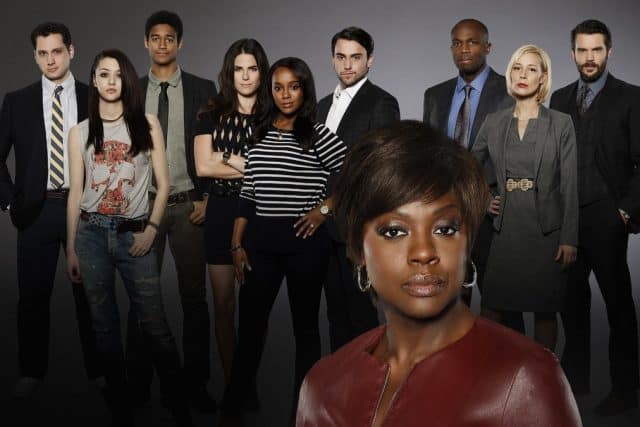
The American Broadcasting Company (ABC) television network is slowly but surely paving the way to diversified television. Sex, murder, infidelity, and an endless supply of mystery are just a few elements found in ABC’s new hit series How to Get Away with Murder. The cherry on top of it all? The show is led by a powerful, unapologetic, black woman — something prime time television has not seen in over forty years. How to Get Away with Murder is a show that is willing to take risks and go there with real societal issues. In doing so, they are ultimately presenting a more realistic depiction of the world and aspects of life that go far beyond the generic, white-washed version of it that television is so used to.
Pop culture has an effortless way of pushing the inherently political to the forefront and with that comes a great deal of responsibility to produce content that actually reflects the world as it truly is. As Andi Zeisler says in Feminism and Pop Culture, “Pop culture informs our understanding of political issues that on first glance seem to have nothing to do with pop culture; it also makes us see how something meant as pure entertainment can have everything to do with politics” (7).
Television is so ideologically charged, relying solely on conventional “realist” forms of image constructions. Rhetorically, the show is doing wonders in highlighting aspects of real life that are often masked by the predominating white discourse of television. Considering the capacity pop culture holds to marginalize, silence, and neglect people who go beyond the mass-mediated norm, it is both refreshing and deserving of admiration to see two prominent producers in television entertainment creating something that provides mirrors for those in society who fall into categories beyond the white men and women that are represented on screen.
Peter Nowalk, a prominent and an openly gay producer in Hollywood, is the creator of How to Get Away with Murder, with Shonda Rhimes as an executive producer. This series, in addition to Rhimes’ other shows like Grey’s Anatomy, or Scandal, is changing the, quite frankly, boring formula of TV dramas. Rhimes is praised for pioneering her way through television — pushing back the threshold responsible for silencing and marginalizing minorities (from race to ethnicity, gender, to sexuality) on television and in the entertainment industry as a whole. Because pop culture plays a huge role in many people’s lives, it is imperative, even in the midst of all of the fiction, that creators, directors, producers and writers produce content responsibly — taking the initiative to create something that accurately depicts and reflects the world we live in.
Regardless of a viewer’s gender, sexual preferences, race, ethnicity, etc. they should be able to turn on the TV and see a realistic representation of him or herself in one form or another. Nowalk and Rhimes provide authentic perspectives and voices for those who have been silenced within various mediums of pop culture. Together they are defying the dominant systemic and structural forces that have played a key role in the oppression of the “others” in society (“other,” referring to women – especially women of color, blacks, Hispanics, Asians, gays, bisexuals, transgender — to name a few). Shonda Rhimes and Peter Nowalk are taking advantage of the platform they have been granted and are changing the landscape of television one character and one series at a time.
How to Get Away with Murder (HTGAWM) made its debut on television screens in 2014. The show’s age demographic ranges between 18-49 and is aimed primarily at young adults (How To Get Away With Murder TV Show on ABC: Ratings (Cancel or Renew?)). HTGAWM provides both realistic and accountable mirrors reflecting real groups in society — especially minority and misrepresented and underrepresented sociocultural groups.
They are accomplishing this through the diverse cast and through the writing and content of the show. HTGAWM follows the pursuits of the powerful, successful law professor and defense attorney named Annalise Keating, played by Viola Davis. The show also follows the pursuits of five of Keating’s star law students, otherwise referred to as the Keating Five. The Keating Five consists of Michaela Pratt (Aja Naomi King), a young black woman who is fiercely ambitious and only outshined in her ruthlessness by Connor Walsh (Jack Falahee). Connor is a gay male who is extremely resourceful and willing to do whatever it takes to get ahead, exploiting anyone and everyone, using his charming good looks or even sex to climb to the top. Laurel Castillo (Karla Souza) is the witty “Latin-American” princess, who is quiet but sharp.
Asher is a pompous white male, nicknamed “douche-face,” who embodies and represents the notion of white privilege. Rounding out the bunch is Wes Gibbins (Alfred Enoch), a young black male, also referred to as “waitlist,” who is the more reserved of the bunch. Despite being constantly underestimated by the rest of the Keating Five, he is equally as savvy and cunning as the rest of the group. Nowalk and Rhimes defy gender norms, in addition to gender and racial stereotypes with this elaborate, complicated, culturally, racially, and sexually diverse group of characters. While each character possesses unique strengths and weaknesses, they are not inherently tied or related to their gender and race. The beauty of the characters of HTGAWM is that every single viewer can find a piece of themselves in, at the very least, one of the characters of the show.
In William Hoynes and David Croteau’s book, Media/Society: Industries, Images, and Audiences, Hoynes and Croteau discuss the ideology of media. They define ideology as “[referring] not only to the beliefs held about the world but to the basic ways in which the world is defined” (Hoynes and Croteau 160). The ideological work of pop culture is embedded in the patterns of media texts, and in television specifically, the ideological works lies in the way it defines and orders its pictures of “reality.” With pop culture being dominated by the same, repetitive images on screen, one must wonder how that directly influences viewers.
In examining the ideology of media, it is important to look into “the broader system of meaning of which these depictions are a part. For ideological analysis, the key is to fit between the images and words in a specific media text and ways of thinking about, even defining social and cultural issues” (161). The depiction of diversity, and especially the depiction of a black woman in a high position of power on How to Get Away with Murder, is truly a part of a much larger system of meaning — one that goes far beyond skin-deep visuals and imagery. The show provides a new lens through which issues such as narrow beauty standards, sexuality, sexual orientation, privilege, and race can be viewed and understood. Hoynes and Croteau argue, “Media texts can be seen as key sites where basic social norms are articulated.”
Television is arguably one of, if not the most, influential mediums of pop culture simply due to its repetitive nature and the role it plays in everyone’s day-to-day life. Television thus possesses the responsibility to provide realistic depictions of both social interactions and social institutions, as they contribute to “shaping broad social definitions.” By suggesting what is “normal” and what is “deviant,” television shows shape their viewers’ understandings of the world they live in.
Until fairly recently, the images that have dominated pop culture, and more specifically television screens, have primarily been of whites, particularly situating white males in positions synonymous with power and authority. Murder mysteries in particular are typically a male-dominated sphere on television; however, Norwalk and Rhimes have flipped the script entirely. Recognized for casting women and racial minorities as leading roles, they challenge the normative representations of black women in the media and the way they are positioned and situated within the hierarchical gender order. They are able to do so by presenting the characters of the show on a relatively equal ground, all while placing a strong emphasis on female agency.
Typically, white women can turn on the TV and see themselves represented in ads, TV shows, films and nearly every other form of pop culture media, whereas minority women are underrepresented entirely. While the representation of women has evolved, to an extent, over the past couple of decades, women have remained heavily sexualized and situated in limiting roles: mother, wife, and girlfriend — essentially serving merely as extensions of the male fantasy. Zeisler mentions that during the early years of the 1970’s, “the not-normally-political TV Guide repeatedly wagged its finger at the industry for refusing to rise above characterizations of women as pretty, skinny, dopey, hapless housewives or housewife wannabes [on network shows]” (75).
She goes on to say that, “75 percent of 120,000 women polled by Rebook magazine in 1972 agreed that the media degrades women by portraying them as mindless dolls” (75). Although this took place during the 1970’s, it is still very relevant to the landscape of television today and the types of roles that are available to women, and especially black women.
Some of the greatest female heroines and femme fatales have been contrived and born in the minds of men. The beauty of a character such as How to Get Away with Murder’s Annalise Keating is that she have been influenced by a real powerful black woman herself and someone who is ultimately able to provide an authentic voice to such a character. The fact that white men are still writing for and about women, in addition to other marginalized groups, is troubling and prompts one to consider when and where empowerment and disempowerment come about and the ways privilege and power are maintained.
Zeisler prompts her audience to ponder the question, “So what could a feminist reclamation of-or just an improvement on-pop culture look like?” immediately following up with: “Well, let’s start with Hollywood: With more feminist directors, producers, screenwriters, and network heads, perhaps women would stop being relegated to wife-and-girlfriend roles in actions movies. Perhaps parts created for women of color would be only more plentiful but also less stereotypical” (20). The character of Annalise Keating does just that, defying stereotypes and pre-molded archetypes of the role of black women in the media.
The audience is introduced to Annalise Keating during the first episode of the show entering her Criminal Law 100 class, showing no sign of mercy to her eager law students. From the way that she dresses, to the strong tone of her voice, to her relentless attitude, and to the overall way she carries her self, it is evident from the very beginning that Annalise is not one to be messed with. The great thing about Annalise is that she is the further thing from a static, one-dimensional character: she is multifaceted with a great deal of depth. She is complex, complicated, fearsome, sexually empowered, flawed and everything in between, pushing boundaries in every possible.
Arguably, one of the most powerful scenes to grace television screens in recent times occurs during the episode “Let’s Go To Scooping” (Season one, episode four), where Annalise discovers that her husband, Sam Keating (Tom Verica), is directly linked to the murder, possibly even the murderer of, and had an affair with his college student Lila Standgard. Annalise, who up until this point has been depicted as an unbreakable force, finally reveals her vulnerable side. In this scene specifically, the camera shifts between close-ups of Annalise and shots positioned from behind as she faces a mirror and slowly removes her weave, eye-lashes, and takes a make-up removing tissue to wipe everything off.
This notion of putting on a “mask,’ both literally and figuratively, before stepping out into and facing the world is a common practice for women everywhere. This scene depicts a reality for women, and especially women of color in a natural un-madeup state. The natural look on Annalise’s face perfectly complements the raw emotion of the scene. During an interview on The Ellen Show, Ellen praises the scene, to which Viola Davis responds saying that she was adamant of having it included in the show. Her reasoning behind such a bold and daring scene was that “[Annalise] can’t go to bed with a wig on. She cannot be in that bedroom with that wig on because women don’t go to bed with their wigs on.
A whole portion of women is marginalized. I’m a real woman!” The decision to include such a powerful scene into the show is an aspect of womanhood that many women, especially women of color can relate to. While she is unforgiving, tough and displays characteristics traditionally believed to be “masculine,” Annalise is also incredibly vulnerable. In such a raw, real, and chilling moment, as a viewer it feels as if Annalise has finally removed her armor, unveiling her core in a sense, and stripping herself of the things that are traditionally considered beautiful. The scene depicts the type of private moment that displays a reality, and it does so through a very public persona. It is without question that women are constantly made to feel insecure due to the impossibly narrow beauty standards to which they are held.
With popular culture filled with images of size two, dolled-up, unobtainable women, many women are made to feel off-balance and lesser. The reason they feel this way is because, often times, the types of images of women that are depicted within the media have come to be accepted as normal. When a woman sees a specific type of look that is depicted as being synonymous as beauty, that shares absolutely no physical resemblance to herself, she is made to feel less beautiful, less of a woman, or that something is wrong with her. During Viola Davis’ SAG awards Acceptance speech for “Outstanding Performance By A Female Actor In A Drama Series, she says, “so I’d like to thank [Peter Nowalk and Shona Rhimes] for thinking that a sexualized, messy, mysterious woman, could be a 49 year old dark-skinned woman that looks like me.”
This powerful statement says a lot about the current state of television and it is depiction of beauty. During Viola Davis’ Emmy acceptance speech, she dedicates her award to the writers and producers of the show for, “redefining what it means to be beautiful, to be sexy, to be a leading woman, to be black.”
To dive even deeper into the complexity of Annalise Keating, her character, in addition to other character on the show (like Connor, for example) push past the hetero-normativity dominating television. During the very first episode, Annalise is caught with another man’s head in her lap — one that is not her husbands. She is sexually empowered and is not ashamed of it. During the middle season one, the audience discovered that Annalise was involved with a woman in college.
“Involved” might even be a bit of an understatement — Annalise had a full-blown lover with her collogues, Eve Rothlo (Famke Janssen), who re-enters and becomes re-involved with Annalise throughout the show. Annalise never explicitly identifies with, or is ever tied to, a specific sexual orientation. Annalise’s “queerness,” if you will, never becomes something the the producers seem overly eager to explain, rather, her sexuality is treated in the same way heterosexuality is in the media — not something that producers feel overwhelmed or consumed to explain. The way Annalise’s sexuality is dealt with is normalized — as it should be.
In Barry Brummett’s “Rhetoric and Popular Culture, he states that artifacts (a TV show in this case), “represent groups to us, [showing] us what it is like to be a part of or to identify those groups, or they remind us of those groups and of what we are committed to by our identification with them.” (55). The way HTGAWM depicts Connor’s sexuality and especially his relationship with Oliver Hampton (Conrad Ricamura) in addition to Annalise’s sexuality and her relationship with Eve, the show speak directly to the reality of a group of people who are misrepresented and underrepresented on telvision. After certain episodes that show intimate and steamy scenes between the gay lovers on the show, there seems to be a great deal of backlash from viewers, expressing their disgust on places like Twitter.
Why is it that something as natural as sex — whether it is heterosexual, but especially homosexual treated as such a taboo? One could obviously argue that it is because the apparent lack of representation of gays within the media. When sex between two men or two women is depicted on screen, it causes uproar because, while it is becoming more common to see on screen, it still has not been completely normalized within pop culture, therefore making it hard for people to digest.
“Popular media [has the] tendency to display a remarkably narrow range of behaviors and lifestyles,” (Hoynes and Croteou 162) and in doing so, the media perpetuates images and depictions that associate certain characteristics with what is considered both normal and accepted in society. Prior to this decade, the depiction of gay relationships, marriages, and sex were heavily treated as a taboo, and in a sense, still very much is. However, shows like HTGAWM are pushing past the powerful forces within the entertainment industry that are responsible for maintaining certain images of society that marginalize those who do not fit into the narrow ideas of reality.
Hegemony, as defined in by Sharon Crowley in Toward A Civil Dicourse: Rhetoric and Fundamentalism, “any set of signifiers and practices, that achieves a powerful, near-exclusive hold on a community’s actions and beliefs” (63). The notion of hegemony connects questions of culture, power, and ideology. “Hegemony operates at a level of common sense in the assumptions we make about social life and on the terrain of things we accept as ‘natural,’ or ‘the way things are.” (Hoynes and Croteau 166). When audiences and viewers do not feel the need to critically evaluate the content they are being exposed to, hegemony is ultimately at play, because at this point, the messages and images have been accepted. Nowalk and Rhimes are redefining what is “normal,” and instead are breaking past the significanty limited portrayals of the “other” on television.
As Zeisler says, “there needs to be a push for women to be unapologetic, and more determined to make spaces in pop culture that represent all the dimensions of the lives of women.” Because pop culture plays a key role in people situating themselves and understanding themselves within the world, it even more so is essential that Rhimes and Nowalk are slowly changing the dialogue within society through a show as powerfully charged as How to Get Away with Murder.
There absolutely needs to be a push for diversity both behind and in front of the camera — again, something that HTGAWM is accomplishing through the unique team of producers and diverse cast. In creating content that depicts more accurate representations of society today, it enhances out ability to not only understand us, and shape our identities, but to also understand those who come from different walks of life – those with different ethnic, sexual, and social backgrounds.
Work Cited
Blacktreemedia. “SAG Awards Viola Davis Gives Moving Victory Speech.” YouTube. YouTube, 27 Jan. 2015. Web. 30 April 2016.
Brummett, Barry. “Rhetoric and Popular Culture.” Rhetoric in Popular Culture. 4th ed. Thousand Oaks, CA: Sage Publications, 2015. N. pag. Print.
Croteau, David, and William Hoynes. “Media and Ideology.” Media Society: Industries, Images, and Audiences. Thousand Oaks, CA: Pine Forge, 2003. N. pag. Print.
Crowley, Sharon. “Belief and Passionate Commitment.” Toward a Civil Discourse: Rhetoric and Fundamentalism. N.p.: U of Pittsburgh, 2006. N. pag. Print.
D’Elia, Bill, and Betsy Beers. “How to Get Away with Murder.” How to Get Away With Murder. Prod. Peter Nowalk and Shonda Rhimes. American Broadcasting Company. 25 Sept. 2014. Television.
“How To Get Away With Murder TV Show on ABC: Ratings (Cancel or Renew?).” TV Series Finale. N.p., 25 Mar. 2016. Web. 25 April 2016.
PrimetimeEmmys. “Viola Davis Gives Powerful Speech About Diversity and Opportunity | Emmys 2015.” YouTube. YouTube, 20 Sept. 2015. Web. 25 April 2016.
Zeisler, Andi. Feminism and Pop Culture. Berkeley, CA: Seal, 2008. Print.
 Follow Us
Follow Us




